
The Atlantic Forest is a South American forest that extends along the Atlantic coast of Brazil from Rio Grande do Norte state in the northeast to Rio Grande do Sul state in the south and inland as far as Paraguay and the Misiones Province of Argentina, where the region is known as Selva Misionera.

The Cerrado is a vast ecoregion of tropical savanna in eastern Brazil, being present in the states of Goiás, Mato Grosso do Sul, Mato Grosso, Tocantins, Maranhão, Piauí, Bahia, Minas Gerais, São Paulo, Paraná and the Federal District. The core areas of the Cerrado biome are the Brazilian highlands – the Planalto. The main habitat types of the Cerrado consist of forest savanna, wooded savanna, park savanna and gramineous-woody savanna. The Cerrado also includes savanna wetlands and gallery forests.
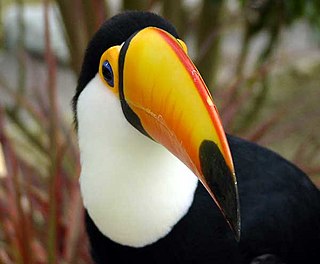
The wildlife of Brazil comprises all naturally occurring animals, plants, and fungi in the South American country. Home to 60% of the Amazon Rainforest, which accounts for approximately one-tenth of all species in the world, Brazil is considered to have the greatest biodiversity of any country on the planet. It has the most known species of plants (60,000), freshwater fish (3,000), amphibians (1,188), snakes (430), insects (90,000) and mammals (775) It also ranks third on the list of countries with the most bird species (1,971) and the third with the most reptile species (848). The number of fungal species is unknown. Approximately two-thirds of all species worldwide are found in tropical areas, often coinciding with developing countries such as Brazil. Brazil is second only to Indonesia as the country with the most endemic species.
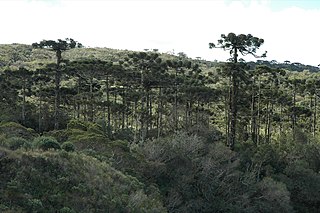
The Araucaria moist forests, officially classified as mixed ombrophilous forest in Brazil, are a montane subtropical moist forest ecoregion. The forest ecosystem is located in southern Brazil and northeastern Argentina. The ecoregion is a southern portion of the Atlantic Forest. The ecoregion also includes select areas of open field called "campos de cima da serra" or "coxilhas".

The campo rupestre is a discontinuous montane subtropical ecoregion occurring across three different biomes in Brazil: Cerrado, Atlantic Forest and Caatinga. Originally, campo rupestre was used to characterize the montane vegetation of the Espinhaço Range, but recently this term has been broadly applied by the scientific community to define high altitudinal fire-prone areas dominated by grasslands and rocky outcrops.
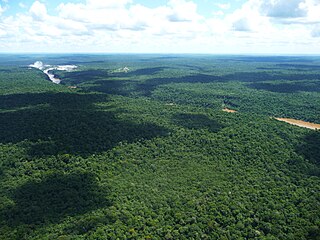
The Alto Paraná Atlantic forests, also known as the Paraná-Paraíba interior forests, is an ecoregion of the tropical moist forests biome, and the South American Atlantic Forest biome. It is located in southern Brazil, northeastern Argentina, and eastern Paraguay.
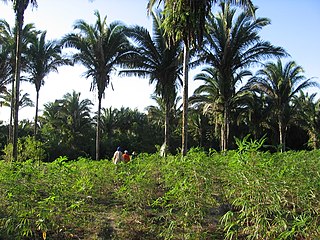
The Maranhão Babaçu forests is a tropical moist broadleaf forest ecoregion of north-central Brazil. The forests form a transition between the equatorial forests of the Amazon biome to the west and the drier savannas and xeric shrublands to the south and east.

The Pernambuco coastal forests is an ecoregion of the Tropical moist broadleaf forests Biome, and the South American Atlantic Forest biome. It is located in northeastern Brazil.
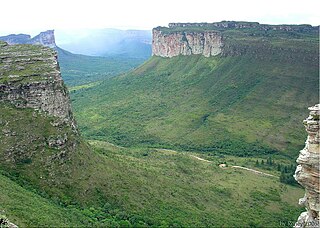
The Atlantic dry forests are a tropical dry forest ecoregion of the Atlantic Forest Biome, located in eastern Brazil.

The Bahia interior forests is an ecoregion of eastern Brazil. It is part of the larger Atlantic forests biome complex, and lies between the Bahia coastal forests and the dry shrublands and savannas of Brazil's interior.
Manilkara rufula is a species of tree in the Sapodilla family. It is endemic to the northeastern submontane forests of Bahia, Sergipe, Pernambuco, Paraíba, Ceará and Piauí states of Brazil. Although this species exists in many places, where it occurs it is either not numerous, or its numbers are declining due to loss of habitat.

The "Pernambuco" interior forests is an ecoregion of the Tropical and subtropical moist broadleaf forests Biome, and the South American Atlantic Forest biome. It lies in eastern Brazil between the coastal Pernambuco coastal forests and the dry Caatinga shrublands of Brazil's interior.

Caatinga is a type of semi-arid tropical vegetation, and an ecoregion characterized by this vegetation in interior northeastern Brazil. The name "Caatinga" is a Tupi word meaning "white forest" or "white vegetation" . The Caatinga is a xeric shrubland and thorn forest, which consists primarily of small, thorny trees that shed their leaves seasonally. Cacti, thick-stemmed plants, thorny brush, and arid-adapted grasses make up the ground layer. Most vegetation experiences a brief burst of activity during the three-month long rainy season.
The Cariri climbing mouse is a partly arboreal rodent species from South America. It is known from two mesic localities in Ceara, northeastern Brazil, within the semiarid caatinga ecoregion. It has been found in areas under cultivation. Cariri is the name of an administrative microregion within the state of Ceará.

The Amazon biome contains the Amazon rainforest, an area of tropical rainforest, and other ecoregions that cover most of the Amazon basin and some adjacent areas to the north and east. The biome contains blackwater and whitewater flooded forest, lowland and montane terra firma forest, bamboo and palm forest, savanna, sandy heath and alpine tundra. Some areas of the biome are threatened by deforestation for timber and to make way for pasture or soybean plantations.

According to IBGE (2004), Brazil has its territory occupied by six terrestrial biomes and one marine biome.

The Serra da Ibiapaba Environmental Protection Area is an environmental protection area in the states of Piauí and Ceará, Brazil. It contains fragments of cerrado, caatinga and Atlantic Forest, and is home to the endangered red-handed howler.

The Tocantins–Araguaia–Maranhão moist forests (NT0170), also called the Tocantins/Pindaré moist forests, is an ecoregion in the north of Brazil to the south of the mouth of the Amazon River. It is part of the Amazon biome. The ecoregion contains the city of Belém, capital of the state of Pará. It is the most developed part of the Amazon region, and is one of the most severely degraded natural habitats of the region.

The Mato Grosso tropical dry forests (NT0140), also called the Mato Grosso seasonal forests, is an ecoregion in central Brazil to the south of the Amazon region. It contains vegetation in the transition between the Amazon rainforest to the north and the cerrado savanna to the south. The opening of highways through the region has caused rapid population growth, deforestation and pollution.



















